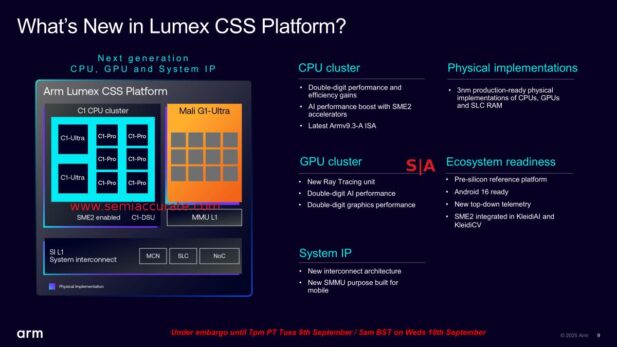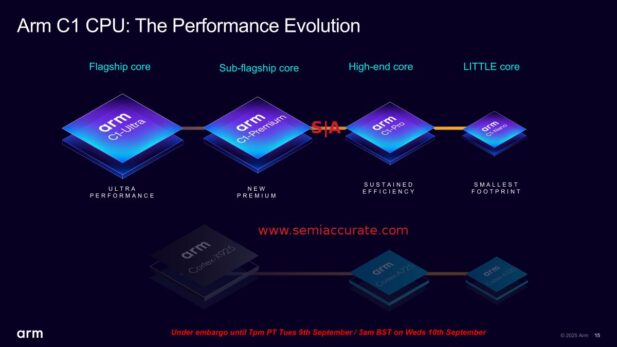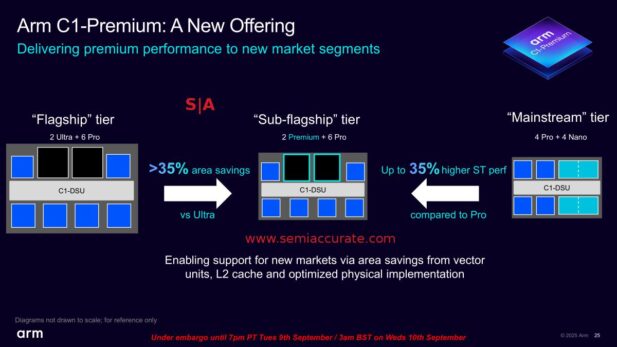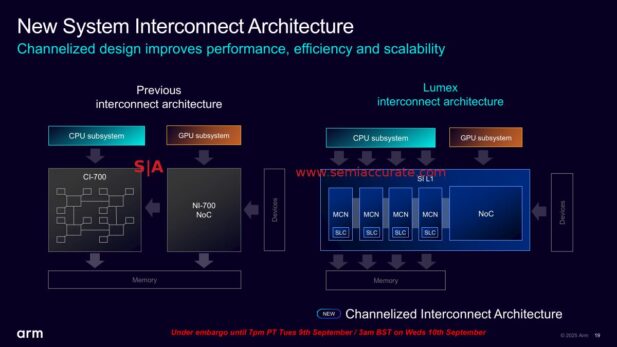A few days ago, ARM released their new lineup for 2026 that starts out with the Lumex rename/brand. SemiAccurate likes the new C1 CPUs, G1 GPUs, and other IP.
Lets start out with the painful and get better from there, rebranding. Sure ARM came out with five brands, four new, a couple of days before Computex, but this time around every IP block has been renamed. Sure there are excuses as to why this is a good idea but, well, ENOUGH ALREADY. In the past few years, ARM CPUs alone have gone from Cortex-Axx two digits to three digits, then to Xy, and now to C1-suffix. GPUs have done the same 2 to 3 digit shuffle, then to Immortalis which just died in an ironic twist, and now G1-suffix. And all of this ignores the name changes to the overarching platforms, interconnects, and other IP.
The problem we see is not that the IP is bad, it is actually very good, just that there is no continuity. What is the modern version of an Cortex-A78? Is an Immortalis-G720 comparable to this generation’s Mali G1-Ultra or G1-Pro? We could go on but you probably get the picture, consistency isn’t just lacking, it seems to be intentionally disregarded. This time around ARM points to the letter/number scheme and says they will be consistent from here on out. While this is what they said the last seemingly 17 times, we hope they are right. Update in a year, but lets get back to the good stuff.

The new ARM Lumex Platform
Here is the heart of the new stuff, the new Lumex platform which is really not this. Lumex is the new CSS for Client which was the new TCS last year if that parses right. In any case this is the default high end client platform ARM says is what the premium devices should use next year. On a technical front it is hard to argue a 2+6 platform with a high end GPU, all the goodies enabled, and AI is anything but a premium device. Lets take a look at the high level changes, the deep tech will come in later articles.

The four new Cortex-C1 lines
The biggest change is the CPUs with the addition of a fourth core type. Big/Little went to Big/Medium/Little a few generations ago and now has become Big/LessThanThatLastOne/Medium/Little, if you don’t count variants like multiple types of smaller cores optimized for performance or efficiency in the same SoC. Qualcomm, we are looking at you here. In any case these are ARMv9.3-A cores with a few v9.4-A features pulled in, this is a good thing.
Better yet is the bit about all cores having the same ISA, all will execute the same code without changes, albeit at very different speeds. There is no AVX-512 flag lottery here, it is all just one ISA, again, this is a very good thing. The cores from high end to low are called Ultra, Premium, Pro, and Nano, abbreviated as C1-U, C1-P, C1-P…oh wait that doesn’t work. How about C1-U, C1-Pr, C1-Pr…damn it! At least Pro is short enough but this one will annoy for years.

C1 cluster comparison
The big change here is that the fourth CPU core class, Premium, is a little less than the Ultra which was the X# cores of the past few years. If you are wondering why anyone would bother with yet another core type, other than to prematurely age the wizards who write schedulers, there is actually a good reason. The slide above points out that going from 2U+6Pro to 2Pre+6Pro configs saves 35% die area for only 25% less performance. Sure the core clusters are a minority of the SoC die but this is a substantial cost savings for a claimed 25% performance loss. Do note this is for a 2MB Ultra vs 1MB Premium core.

ARM C1 cluster lineup
So how much savings can you get with the official ARM configurations? As you can see going from the Lumix Lumex 6+2 platform to a 2x Nano cluster gets you a 25x area savings. That is not percent, it is times, and the ISA stays the same. Performance goes up a ‘mere’ 17x so is it worth it? If you are making a ‘smart’ TV, then the area savings are likely well worth it, but a high end smartphone may see things differently. In any case you get an idea of the range of the 2026 CPU clusters scalability for area and performance, it is pretty wide.

The new Lumex Interconnects
On the system plumbing front we have a major change that doesn’t sound like much but will have big efficiency benefits. The previous CI-700 and NI-700 interconnects are replaced by a single fabric called SI L1 or System Interconnect (presumably) Lumex 1. The old MMU is now replaced by the new MMU L1 and it all ties together more tightly. If you look at the cost of moving bits in a modern SoC vs the cost of computing them, you will understand why these changes matter a lot.

Don’t forget the new G1 GPU line
That brings us to the enthusiast’s favorite topic, GPUs and the new Mali G1 family of devices. At a high level there isn’t nearly as much change here as there was on the CPU side, three configurations that are more unit counts than significantly different IP blocks. The G1-Ultra is a 10+ core beast with mandatory raytracing, G1-Premium goes from 6-9 cores and doesn’t have to have raytracing, and the G1-Pro is 1-5 cores. Within the cores things are very different, but again that is for another article.
In past iterations of Mali you could configure the cores themselves to have different ratios of units in them, especially at the low end where 3D was less of a priority than pixel pushing, think TV/video controllers vs gaming devices. That feature seems to be a thing of the past but most of the low end devices there will probably stick with older GPU families for area and cost savings, if the new features are not going to be used, why pay for them?
The changes to the Mali G1 levels are not simply unit counts though, the plumbing is changed between levels. Why? The less units you have the less bandwidth and interconnects you need to feed them, the less I/O ports you need and so on. Each level of Mali fits the plumbing to the available compute capability for greater efficiency and lower cost. This may seem obvious because, well it is. We will get into the changes to the GPU cluster itself in detail in later articles.
If these new CPUs and GPUs sound iterative, they kind of are at a high level, with the exception of the new C1-Premium they are all updates to existing IP blocks. This isn’t to damn them with faint praise, there is a lot of good in them with many new features we will cover later. The biggest bang is the uncore, the SI L1 is really new and different as are the changes to the DSU itself. If the new naming scheme sticks around, I think ARM is on to a very good thing with this generation of IP.S|A
